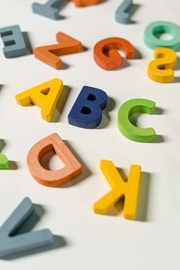How to Teach My Child Alphabet Recognition
Alphabet, or letter recognition, is a foundational skill that is essential for learning to read and write. Children with a solid grasp of letter recognition can identify both upper and lowercase letters, in different contexts, in any order. Letter recognition goes beyond singing the “ABCs,” which only teaches children to recite the alphabet from memory.
To be proficient with letter recognition, children also need to be able to distinguish the physical characteristics of each letter. Letter recognition can begin at a very young age, with reading babies and toddlers alphabet books.
There are tremendous benefits to reading aloud to children, and books about the alphabet are no exception. Alphabet books provide children with exposure to letter names and their appearance. There are board books, storybooks, and books written in rhyme to choose from.
After your new baby arrives at home, education on letters and words is the last thing on your mind, even though their learning journey as already begun. As children get older, they may begin recognizing some letters of personal significance, beginning with the letters in their name.
It is not uncommon for children to recognize the first letter in their name and later, to begin identifying others. This is a great starting point for teaching letter recognition. Take advantage of teachable moments to point out letters in the environment. For example, show your child how the letter on the sign is the same as the letter in her name.
Young children can benefit from tactile ways to interact with letters. One way to provide these opportunities is through the use of alphabet puzzles. In addition to the letters, alphabet puzzles often use pictures to represent the sound each letter makes. This is a great way for children to start associating letters with a picture, which can act as a cue to its sound.
Another tactile way for children to use letters is through the use of playdough. They can create the letters, either on their own, or with the help of a playdough mat that shows the outline of each letter.
Alphabet printables provide many different ways for children to work with letters. Choose from activities like mazes, spinners, tracing sheets, letter hunts, and flip books. These activities help children learn the letter names, distinguish their physical characteristics, and begin learning the sound each letter makes.
It can be helpful to have the alphabet displayed for children to refer to. This can be a premade alphabet chart or cards that you purchase from a store. Typically, they show the correct formation of each letter along with a picture that represents the letter sound. Alternatively, you can involve children in the creation of alphabet cards and have them choose pictures or items that represent each letter sound.
Having them choose the pictures can make the activity more meaningful and help them remember the sounds more easily. For example, children may choose to associate the letter “f” with a frog. The hope is that when they see the letter “f” in another context, they will think of the frog and be cued to the correct sound an”f” makes.
When focusing on letter recognition, it is important for children to learn both the upper- and lowercase letters of the alphabet. In addition to the activities outlined above, matching provides another way for children to see the physical differences between upper- and lowercase letters. Provide them with opportunities to use materials like magnetic letters, letter tiles, stamps, or stickers to match the upper- and lowercase letters. It can be overwhelming to work with the entire alphabet, so begin with a few known letters and add in one or two new ones.
There are lots of ways to teach children the letters of the alphabet. Choose different activities to keep them engaged and provide lots of encouragement as they begin the exciting journey of becoming a reader!




